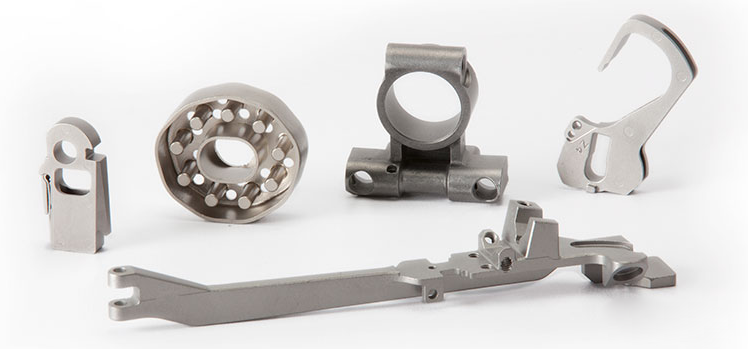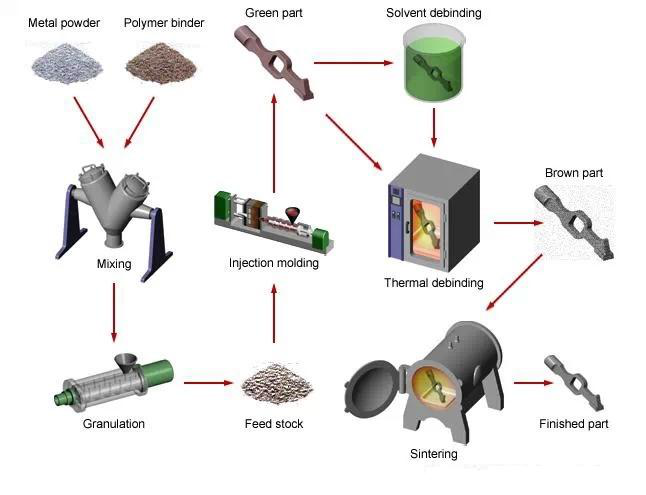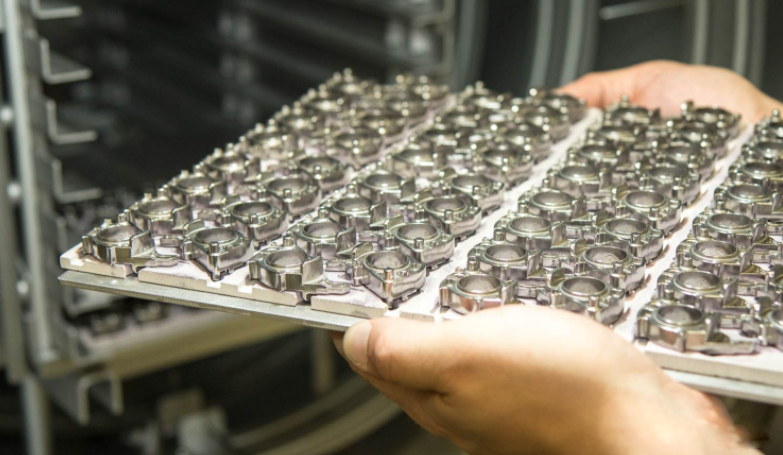Metal Powder Injection Molding MIM Technology and Design Guidelines
Metal Powder Injection Molding Technology (Metal Powder Injection Molding Technology, referred to as MIM) is the introduction of modern plastic injection molding technology into the field of powder metallurgy and the formation of a new type of powder metallurgy near-net shape technology. The use of molds can be injection molding blanks and through the sintering of high-density, high-precision, three-dimensional complex shape of the structure of the parts, can quickly and accurately materialize the design of ideas for a certain structure, functional characteristics of the products and can be directly mass-produced parts, is the manufacturing technology industry, a new change.

MIM injection molding equipment needed: granulation machine, MIM special injection molding machine, degreasing furnace, sintering furnace, testing equipment, secondary processing equipment.
The future development of powder injection molding is mainly in the material and design efforts to use the advantages of the process to help customers improve product design and reduce costs, thereby expanding the application of powder injection molding.
First, the process of metal powder injection molding (MIM) products is:
Powder + binder → mixing → granulation → injection molding → degreasing (MIM degreasing furnace) → sintering (MIM sintering furnace) → subsequent processing → molded products. In the process of producing MIM Cemented Carbide parts, any one of the links of material selection, operation control is not appropriate may cause defects in the Cemented Carbide parts, then how to avoid such defects?

1, powder selection process. MIM Cemented Carbide Powder Metallurgy in addition to meet its particle size distribution, particle size and other basic requirements, but also requires that the purity of the powder should be high, can not be selected to clip impurities in the powder, if the powder is intermingled with sulfur, phosphorus, silicon and other elements, the sintering process of these substances will be formed in the pore, resulting in defects in the product.
2, feeding the production link. Cemented carbide powder in the mixing of the need for a suitable binder, mixing of cemented carbide powder and binder fully mixed, the mixing process must be strictly controlled temperature, to avoid binder volatilization and uneven distribution of the situation, so that the mixture made of feed with good rheological properties and viscosity value, to avoid defects in the subsequent links.
3、The link of forming billet. This is also a key link in the production of cemented carbide parts, to avoid product defects, need to pay attention to the injection process, reasonable control of mold temperature, charging volume, injection pressure, holding pressure, holding time, injection speed, etc., can effectively avoid the defects of the injection of billet.

4, degreasing link. Degreasing of cemented carbide billet, in the process of degreasing, if the degreasing furnace heating speed is too fast, it will cause crack defects of cemented carbide parts, and it can be degreased by adopting step-by-step heating method.
5、Sintering link. Cemented carbide density, liquid phase sintering due to its own gravity, products are prone to deformation. Appropriate support devices can be used for larger products can be selected shrinkage rate of the material as a support plate, in addition should be as short as possible to shorten the liquid phase sintering time.

Second, the common defects of metal powder injection molding parts are as follows:
1, under-injection: under-injection refers to the lack of pressure from the injection molding machine used or the poor fluidity of the injection material used and other factors caused by the material failed to fill the entire mold cavity so that the injected products appear incomplete. The reasons for under-injection of poor material fluidity, wall thickness of the product is too small, the mold temperature is too low and the injection time is too short, can be taken accordingly to improve the fluidity of the material or to replace the material, increase the wall thickness, enhance the mold temperature, increase the injection pressure and prolong the injection time and other measures to solve the problem.
2, fusion marks: material in the injection process in the cavity into a number of streams and then converge together, the convergence may appear line-like traces, that is, fusion marks, affecting the appearance of the quality of the product and even mechanical strength. The reasons for the formation of fusion marks for the injection pressure is too low, the injection speed is too slow, the material and the mold temperature is too low and the material flow too many strands, can be taken accordingly to increase the injection pressure, speed up the injection speed, improve the material and the mold temperature and reduce the shunt and other measures to solve the problem.
3, air pockets: in the injection process, the air inside the mold cavity can not be discharged in time, the material is wrapped with or compressed to the mold wall to form air pockets, resulting in the surface of the product is not injected, affecting the appearance of the quality of the product and even mechanical strength. Formation of air pockets in the original Gang for the exhaust bad, inappropriate location of the gate, the injection speed is too fast and the thickness of the product is too large changes can be taken accordingly to add exhaust holes or deepen the exhaust holes, change the location of the gate, slow down the injection speed, extend the holding time and avoid drastic changes in the thickness of the product and other measures to solve.
4, deformation: deformation refers to the molding products after cooling, bending or twisting, directly affecting the appearance of the product size accuracy, and even cause products scrapped. The causes of deformation for the products cooling is not uniform, the products are too hot and too early top, the products are too thin and unreasonable structure and the products of the internal residual stress, can be taken accordingly mold waterway uniform cooling, extend the holding time and timely top out of the products, improve the products wall thickness and structural design and to improve the molding conditions, and other measures to be resolved.
Powder metallurgy product size tolerance standards
Powder metallurgy injection molding, compression molding standards, all mixed powders, bulk density, compressibility, particle size distribution, fluidity is very good. However, the products made, according to each type of powder metallurgy parts are produced with the dimensional tolerances specified on the drawings.
The dimensional tolerances of the parts vary depending on their use. Generally speaking, the narrower or more precise the dimensional tolerance, the higher the production cost, which greatly increases the production cost of the part. Therefore, size is one of the most important factors in the price of powder metallurgy parts.
Generally speaking, the dimensional tolerances of the parts should be as good as possible, but also can reduce the parts of the scrap rate, so that the production costs can be reduced to a minimum, the first technical ability has been up, the tolerance can be done to two thousandths.
Sintered parts materials in the sintering size change law, such as expansion and contraction after the combination of sintering, powder compression embryo or fusion casting metal parts into one, made of a more complex shape or different parts with different functions of the composite parts, in the sintering can be jointed together, sintered out of the product size is consistent.
There are also some methods of sintering, the use of sintered embryo material size changes in the combination of methods, has been successfully used in a variety of powder metallurgy parts materials, for stainless steel parts, often using high-temperature vacuum sintering for the combination of connection for the conventional sintering furnace protective atmosphere for the hand sintering connection. Control the size of the parts and accuracy standards.
Design Guidelines of Metal Injection Molding
Here are 14 design guidelines of Metal Injection Molding. They pretty much follow the same principles as Plastic Injection Molding.
MIM effectively maintains a minimum wall thickness of 0.012” or 0.3mm.
It can go up to maximum wall thickness of 0.30” or 8mm
The design needs to consider a gate location which is also the injection points on a part.
We can remove these gate mark in secondary finishing later.
Parting lines and ejector pin marks need to be considered in design.
Minimum corner radius of 0.004” or 0.1mm can be achieved.
Larger the corner radius, better it would be.
Minimum feature size on the component is around 0.012” or 0.3mm
Logos or texts can be added on the surface as needed.
Draft angles of 1 to 5 degrees can be considered.
To consider threads in your part, inter and external threads up to M5 (10-32) can be considered for molding.
Any larger size or finer threads need to be finished machined.
Collapsible cores are used for larger under-cut features.
MIM Molds can accommodate hydraulic or electric actuators
In addition to these above 14 important design guidelines, experienced designers can help you understand any missing guidelines to be considered in your part. These design guidelines primarily help with the material flow inside the cavity. No two parts are the same, so it does take a lot of knowledge and experience to advise you on the right error free MIM design.
Ejector marks, parting line, gating, part thickness, corners, holes, and undercuts must be considered during the design phase. Fixtures must support hanging sections of the parts to prevent sagging.

Summary
Metal powder injection molding (MIM) can be formed into complex shapes of cemented carbide products, with the solution of the problem of defect control, the gradual improvement of MIM technology, so that the application range of cemented carbide is gradually expanding, which greatly promotes the development of the entire cemented carbide industry.
Cemented carbide powder needs suitable binder when mixing, mixing the cemented carbide powder and binder fully mixed, mixing process must be strictly control the temperature, to avoid the binder volatilization and uneven distribution, so that the mixing material is made into a feeder with good rheological properties and viscosity value, to avoid defects in the subsequent links.










